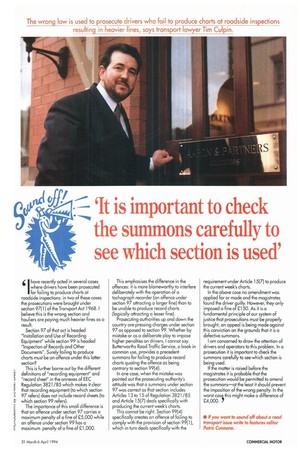'It is important to check the summons carefully to see which section is used'
Page 51

If you've noticed an error in this article please click here to report it so we can fix it.
6 1 have recently acted in several cases
where drivers have been prosecuted for failing to produce charts at roadside inspections: in two of these cases the prosecutions were brought under section 97(1) of the Transport Act 1968. I believe this is the wrong section and hauliers are paying much heavier fines as a result.
Section 97 of that act is headed "Installation and Use of Recording Equipment" while section 99 is headed "Inspection of Records and Other Documents", Surely failing to produce charts must be an offence under this latter section?
This is further borne out by the different definitions of "recording equipment" and "record sheet" in the annexes of EEC Regulation 3821/85 which makes it clear that recording equipment (to which section 97 refers) does not include record sheets (to which section 99 refers).
The importance of this small difference is that an offence under section 97 carries a maximum penalty of a fine of £5,000 while an offence under section 99 has a maximum penalty of a fine of 21,000. This emphasises the difference in the offences: it is more blameworthy to interfere deliberately with the operation of a tachograph recorder (an offence under section 97 attracting a larger fine) than to be unable to produce record charts (logically attracting a lesser fine). Prosecuting authorities up and down the country are pressing charges under section 97 as opposed to section 99. Whether by mistake or as a deliberate ploy to impose higher penalties on drivers, I cannot say. Butterworths Road Traffic Service, a book in common use, provides a precedent summons for failing to produce record charts quoting the offence as being contrary to section 9914). In one case, when the mistake was pointed out the prosecuting authority's attitude was that a summons under section 97 was correct as that section includes Articles 13 to 15 of Regulation 3821/85 and Article 15(7) deals specifically with producing the current week's charts. This cannot be right. Section 99(4) specifically creates an offence of failing to comply with the provision of section 99(1), which in turn deals specifically with the requirement under Article 15(7) to produce the current week's charts.
In the above case no amendment was applied for or made and the magistrates found the driver guilty. However, they only imposed a fine of 2150. As it is a fundamental principle of our system of iustice that prosecutions must be [Properly brought, an appeal is being made against this conviction on the grounds that it is a defective summons.
I am concerned to draw the attention of drivers and operators to this problem. In a prosecution it is important to check the summons carefully to see which section is being used. If the matter is raised before the magistrates it is probable that the prosecution would be permitted to amend the summons—at the least it should prevent the imposition of the wrong penalty. In the worst case this might make a difference of
£4,000.






























































































